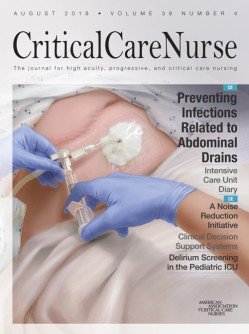
Credit: Critical Care Nurse
(NEWSWISE)–Small changes led to lower noise levels during designated quiet times in a New York hospital, according to a study published in Critical Care Nurse (CCN).
Nursing staff from North Shore University Hospital, Manhasset, New York, developed an initiative to reduce noise levels in the 16-bed neurosurgical intensive care unit (NSCU) in response to concerns about how noise was negatively affecting family satisfaction, patient sleep, staff stress levels and concentration.
Through a combination of reducing noise and adjusting the times for noisy activities, the unit was able to reduce noise levels and maintain quiet times with reductions in peak noise events six months after education and implementation.
North Shore University Hospital nurses share their strategies and results in “Quiet Time: A Noise Reduction Initiative in a Neurosurgical Intensive Care Unit,” published in CCN’s August 2018 issue.
Using a decibel meter, the NSCU staff measured noise levels on the left and right sides of the nurses’ station, which serves as the central hub for the unit and is shared by many providers. Noise was also measured in front of two patient rooms near the nurses’ station, one of which is also near the primary entrance to the unit. Data was collected for eight days prior to staff education and again six months after quiet time was implemented.
After the initial data was collected, the baseline results were shared with staff through unit-based in-services, staff meetings and journal club sessions. Education on the benefits of quiet time was provided to all members of the NSCU team, including members of other departments. All department directors were notified about the initiative.
The unit then implemented quiet time periods twice each day, from 3 to 5 a.m. and from 3 to 5 p.m. During quiet times, lights were dimmed, whispering was encouraged and environmental noise was eliminated as much as possible.
“A darkened unit provided a strong visual cue to be quiet, but reducing noise required a comprehensive team effort,” said Kerri Scanlon, MSN, chief nursing officer. “Together, we were successful in changing unit practice and enhancing awareness about excessive unit noise.”
Among the specific changes that contributed to lower noise levels during quiet time:
- Unit secretaries offered reminders to visitors, dimmed lights and eliminated overhead paging in the unit.
- NSCU physicians and physician assistants shifted the start of their daily teaching rounds to complete them prior to the afternoon quiet time.
- Physical and occupational therapists adjusted their schedules to see patients before 3 p.m. each day.
- Environmental services personnel agreed not to buff the floors during quiet time.
- A staff checklist itemized tasks to be performed prior to quiet times, such as administering routine medications, taking vital signs, turning off televisions and putting mobile phones and pagers to vibrate.
- Other materials included a unit-specific brochure explaining quiet times, signage on each patient door and at unit entrances, and hospitality bags with items such as sleep masks and earplugs.
- Working with the clinical alarm committee, the NSCU underwent a smart-monitor upgrade for each patient room and the central stations, which helped reduce nuisance alarms. In addition, NSCU leadership revisited alarm parameters and adjusted the default settings for monitors.
After six months, the quiet times decreased peak noise levels, with results 10 to 15 decibels lower than baseline data during the designated times. The difference was statistically significant in two of the four locations, while the two busiest locations experienced quieter but not statistically significant noise reductions.
The initiative also identified areas for improvement, such as installing push-plate automatic opening functions at the rear entrance to the unit for easier access by emergency department and operating room teams and identifying a different time and space for physicians and physician assistants to conduct teaching sessions.


